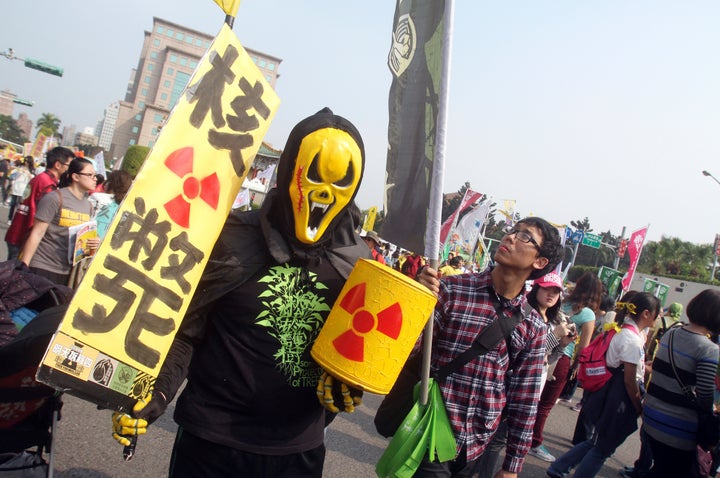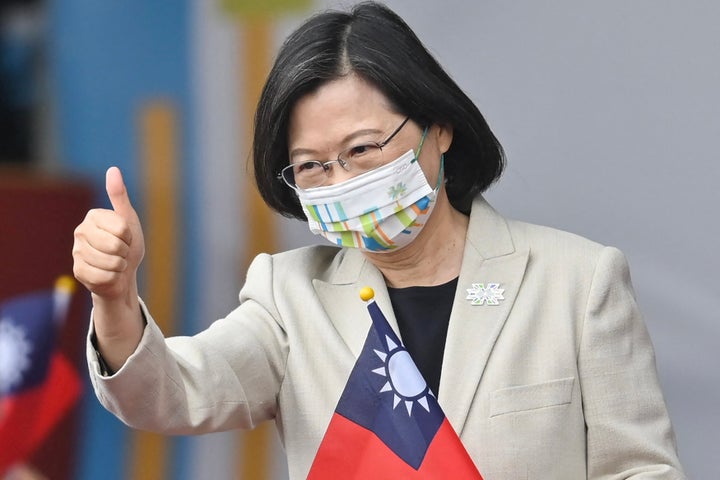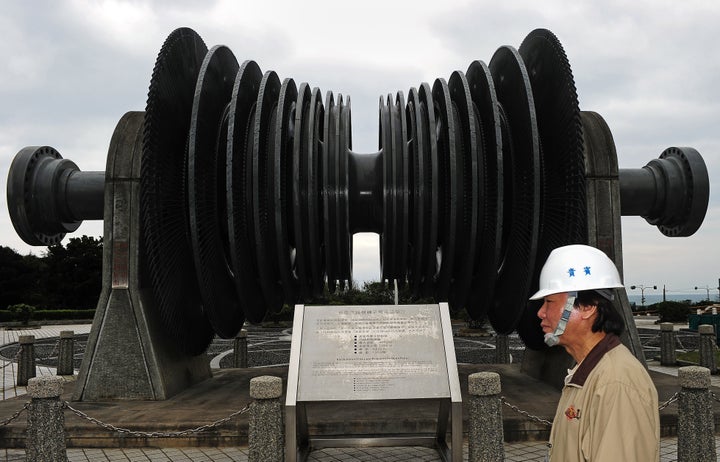
Taiwan has closed yet another nuclear power plant, risking potentially deadly blackouts this summer, rendering the self-governing island more vulnerable to a Chinese blockade, and threatening a surge in greenhouse gases from one of the world’s top 25 emitters.
The center-left government of President Tsai Ing-wen had already shuttered both reactors at the Jinshan Nuclear Power Plant, Taiwan’s first atomic power station, in 2019. In 2021, her administration halted one of the two reactors at the Guosheng Nuclear Power Plant, the island’s second such plant.
On Tuesday, the facility’s second and final reactor permanently went offline, leaving just one nuclear plant operating in Taiwan. The two reactors at that final station, the Maanshan Nuclear Power Plant located near the southern tip of the oval-shaped East Asian island, are slated to go dark in the next two years, fulfilling the ruling Democratic Progressive Party’s promise of a “nuclear-free homeland” by 2025.
Over the past 10 years, Taiwan has built 1 gigawatt of wind power and 10 gigawatts of solar — tremendous strides that nevertheless fall far short of the government’s ambitions and leave the densely-populated nation of nearly 24 million dependent on fossil fuels for nearly 90% of its electricity needs.
From an emissions perspective, “decommissioning Guosheng is essentially as if they’ve bulldozed one-third of that” renewable generation, said Seaver Wang, the co-director of the energy and climate program at the Breakthrough Institute, a California-based environmental think tank that supports atomic energy.
“It both erodes the laudable progress that Taiwan has been making in other areas of clean energy while also making Taiwan’s energy situation more precarious in the near term,” said Wang, who researches energy policy across East Asia.
Keeping Guosheng and the last two reactors at Maanshan operating for another 10 years and retiring equivalent coal plants instead, he said, would have offset Kenya’s entire annual output of fossil fuel emissions.

Nuclear energy, which at one point provided more than half of heavily industrialized Taiwan’s electricity, is a thorny issue in most places, but especially there. Its reactors were all built under a military dictatorship that, in the 1970s, brutally displaced Taiwanese living on the sites of the future plants as the regime attempted to develop nuclear weapons. For many, the nuclear plants are a symbol of those dark days.
Fears of radioactive waste also run deep in a nation that neighbors Japan, where the only atomic bombs dropped in wartime fell and where the world’s most recent reactor meltdown occurred.
Taiwan’s unusual status as a functionally independent republic that much of the world recognizes as part of China also limits its ability to advocate for itself in complex global negotiations over nuclear energy, and an agreement with the U.S. has left Taipei subject to Washington’s rules over how it manages its own uranium fuel.
Shortly after taking office in 2017, Tsai — whose party has opposed nuclear energy since it formed in 1986, five months after the Chernobyl disaster in Soviet Ukraine — signed a law mandating the phaseout of Taiwan’s reactors. Though the Guosheng reactor still had years left on its operating license, the Tsai government turned it off in 2017 in hopes of hastening the closures, but restarted the machine in 2018 following islandwide blackouts. That license expired this week.
At a press conference on Monday, the Ministry of Economic Affairs, which oversees the state-owned Taiwan Power Company, said the opening of the new gas-fired Datan power plant in the northern industrial hub of Taoyuan County and a smaller coal-burning station further south in Miaoli County would offset the loss of steady, carbon-free electricity from the Guosheng nuclear station.
The ministry said that if the demand for electricity eclipses supply on the grid — say, if air conditioning spikes during a heat wave — it could generate additional power from its hydroelectric dams.
But Tsung-Kuang Yeh, a nuclear scientist and grid expert at National Tsing Hua University in the northwest city of Hsinchu, said Taiwan will still be operating at a net loss of electricity.
The total capacity of Guosheng’s two defunct reactors is still higher than the combined output of electricity from the coal and gas plants opened in the last two years, Yeh said.

Heavy rains last year increased how much electricity Taiwan’s hydroelectric dams produced to 5.8 billion kilowatt-hours. But the year prior, they generated 3.5 billion kilowatt-hours — the average volume for the last 10 years, according to Yeh’s estimates.
Guosheng’s Unit 2 alone produced 8 billion kilowatt-hours of electricity per year.
“It doesn’t add up,” Yeh said. “We are starting to face the serious risk of blackouts this summer.”
Yeh said the government could have issued an emergency operating license, like the ones Germany granted its remaining nuclear plants last year when Russia’s invasion of Ukraine sent Europe scrambling for alternatives to the Kremlin’s newly weaponized exports of natural gas.
But Economic Minister Wang Mei-hua said it would be impossible to extend the licenses unless the mayor of New Taipei City, Hou You-yi, agreed to permit new storage facilities for the Guosheng plant’s radioactive spent fuel — a touchy issue in an earthquake-prone region haunted by the 2011 meltdown disaster at the nuclear plant in nearby Fukushima, Japan.
Taiwan’s operating permits require the final load of spent uranium fuel to be stored in the reactor after it’s shut down — making it impossible to either refuel or demolish the unlicensed machine until otherwise granted permission.
There’s also a political incentive to pass the buck off to the mayor. Hou, a member of the opposition Kuomintang party, is seen as a potential presidential contender in next year’s election.
As that election looms, the term-limited Tsai may be eager to cement her legacy by completing the nuclear phaseout that her Democratic Progressive Party, which is largely defined by its opposition to eventual reunification with China, had long promised.
“She is betting that there won’t be a huge blackout this summer,” Yeh said. “During her presidential campaigns both times, she always said that we are going for a nuclear-free homeland. Her term is ending in one year. She wouldn’t take the chance for it to be said that she had a bad energy policy.”
Tsai’s vice president, William Lai, is widely expected to run as her successor next year, and he’s seen by some as more open to potentially keeping nuclear plants open in Taiwan.
Yet choosing that path is a difficult one: It’s already too late to begin the often yearslong relicensing process. The two reactors at Taiwan’s only remaining nuclear plant are scheduled to close in July 2024 and May 2025, respectively.
“There is a sense that the 2025 timetable for a nuclear-free Taiwan explicitly builds in room for one more reevaluation via the political cycle with the national election,” Wang said. “I’ve heard some speculation that this might be an opportunity for a shift on nuclear policy. Of what magnitude? Who knows.”
“If you were to get all your ducks lined up in a row, you could actually recommission those plants. They haven’t gone beyond the point of no return yet.”
- Seaver Wang, co-director at the Breakthrough Institute
Since Taiwan’s decommissioned reactors remain with their last fuel intact, a future government could, in theory, relicense them if it receives approval to store the spent uranium elsewhere.
“If you were to get all your ducks lined up in a row, you could actually recommission those plants,” Wang said. “They haven’t gone beyond the point of no return yet.”
The latest closures could revive a complex debate over energy security on an island whose contested sovereignty is widely discussed as a possible trigger for a world war. China claims Taiwan as a breakaway province, yet the Communist Party government in Beijing has never ruled the island of more than 24 million people, which was a Japanese colony for 50 years before the nationalist Kuomintang forces fled after losing the Chinese Civil War in 1949.
After decades of despotic one-party military rule under the Kuomintang — when Taiwan’s nuclear reactors were all built — Taiwanese people rose up in the 1980s and ultimately won democracy, holding their first free elections in 1996. Since then, the republic — which is diplomatically recognized by just over a dozen nations, but trades worldwide as the top manufacturer of the microchips needed for most facets of modern life — has transformed into such a democratic society that it ranks alongside Iceland and Estonia for transparency and good governance, far above the U.S.
While the reformed Kuomintang today advocates closer ties with Beijing, the Democratic Progressive Party’s energy policies have made it easier for China’s military to put pressure on Taiwan. When the Chinese military launched missiles around the island following then-U.S. House Speaker Nancy Pelosi’s visit to Taipei last summer, barges shipping liquefied natural gas to Taiwan rerouted away from those ports, highlighting the risk of a blockade to a fuel source that requires near-constant imports.
By contrast, nuclear reactors can provide 24/7 carbon-free electricity for years without being refueled.
Yet it’s not that simple. Russia dominates the global market for uranium fuel and nuclear energy exports. A 2014 agreement with the U.S., signed by the pro-nuclear former President Ma Ying-jeou, permanently barred Taiwan from enriching its own uranium fuel or reprocessing waste in exchange for access to American nuclear exports. But as the U.S. struggles to keep its own reactors open and provide specific types of fuel to proposed new ones, that so-called “gold standard” deal requires Taipei to ask Washington’s permission to do virtually anything related to its own civilian nuclear program.
Perhaps counterintuitively, Daniel Chen, a Taiwanese pro-nuclear advocate, said that this dynamic makes closing Guosheng “sound policy” for energy security since maintaining the facility would require submitting to the U.S., which has shuttered more than a dozen of its own reactors in the last 15 years.
“Getting rid of a plant that uses fuel sources from one singular country (who will just sell you laundered Russian materials anyway) is, contrary to pro-nuclear orthodoxy, GOOD for energy security,” Chen, a graduate student in nuclear engineering at Ontario Tech University in Canada, told HuffPost in a text message.
Without policy changes that would allow Taiwan to manage its own nuclear fuel, he said, maintaining the plant would leave Taipei “even more susceptible to U.S. coercion.”
Neighboring countries are taking a different approach. South Korean President Yoon Suk-yeol has vowed to restore the glory of his country’s world-renowned nuclear industry, reversing the anti-nuclear policies of his predecessor. Japan is not only restarting the reactors it mothballed after Fukushima; it’s making plans to build more. Of the nearly 55 reactors under construction worldwide, nearly half are in China.
